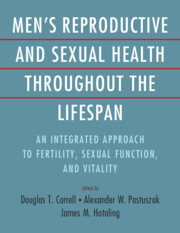 Men's Reproductive and Sexual Health Throughout the Lifespan
Men's Reproductive and Sexual Health Throughout the Lifespan from Section 4 - Laboratory Evaluation and Treatment of Male Infertility
Published online by Cambridge University Press: 06 December 2023
Over the past 20 years, there has been growing interest in understanding the genomic integrity of human spermatozoa and the clinical relevance of sperm chromatin and DNA defects. We have learned that the etiology of human sperm DNA damage is multi-factorial and that sperm DNA defects are associated with abnormal semen parameters. While we have observed that tests of sperm DNA integrity are correlated with reproductive outcomes, use of these complementary biomarkers in the management of male infertility remains controversial. In this chapter, we review the etiologic factors associated with sperm DNA damage and the utility of these tests in clinical practice. We also review the treatment options for infertile men with sperm DNA damage.
To save this book to your Kindle, first ensure [email protected] is added to your Approved Personal Document E-mail List under your Personal Document Settings on the Manage Your Content and Devices page of your Amazon account. Then enter the ‘name’ part of your Kindle email address below. Find out more about saving to your Kindle.
Note you can select to save to either the @free.kindle.com or @kindle.com variations. ‘@free.kindle.com’ emails are free but can only be saved to your device when it is connected to wi-fi. ‘@kindle.com’ emails can be delivered even when you are not connected to wi-fi, but note that service fees apply.
Find out more about the Kindle Personal Document Service.
To save content items to your account, please confirm that you agree to abide by our usage policies. If this is the first time you use this feature, you will be asked to authorise Cambridge Core to connect with your account. Find out more about saving content to Dropbox.
To save content items to your account, please confirm that you agree to abide by our usage policies. If this is the first time you use this feature, you will be asked to authorise Cambridge Core to connect with your account. Find out more about saving content to Google Drive.